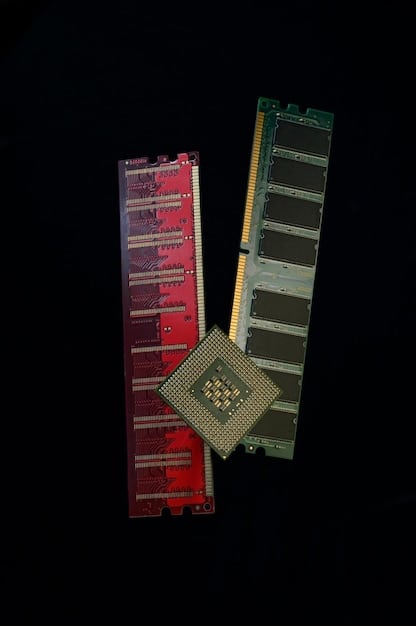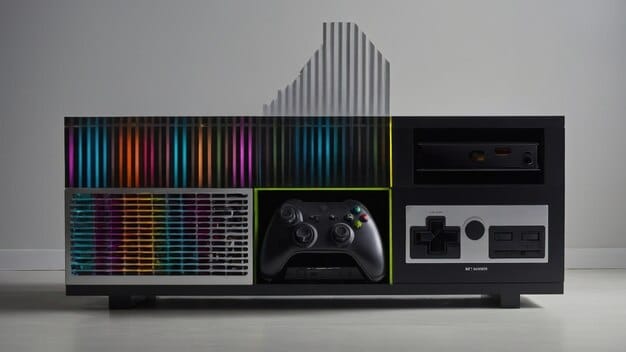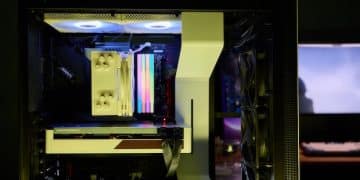Console Gaming Hardware: PlayStation vs. Xbox Specs & Performance

Console gaming hardware encompasses the technical specifications and performance capabilities of gaming consoles like PlayStation and Xbox, influencing game visuals, speed, and overall gaming experience.
Delving into the specifications and performance of console gaming hardware: Understanding the Specs and Performance of PlayStation and Xbox requires a keen eye for detail, as these components directly shape the gaming experience.
Understanding Core Console Hardware Components
The performance of modern gaming consoles is primarily dictated by a collection of essential hardware components. Examining these elements provides a clearer picture of how each console handles the latest games, graphical demands, and processing tasks.
CPU (Central Processing Unit)
The CPU is the brain of the console, handling the game’s logic, AI, and physics calculations. Its speed and number of cores impact how smoothly the game runs and how complex the game world can be.
GPU (Graphics Processing Unit)
The GPU is responsible for rendering the game’s visuals, including textures, lighting, and effects. A more powerful GPU allows for higher resolutions, better graphical fidelity, and smoother frame rates.
- Clock Speed: Indicates how fast the GPU can process data.
- Memory: Sufficient video memory is crucial for handling high-resolution textures.
- Architecture: Newer architectures bring efficiency and advanced rendering techniques like ray tracing.
Assessing both the CPU and GPU is critical to truly understand a console’s capabilities. These components must work cohesively to deliver optimal gaming performance.
PlayStation Hardware Specifications: A Deep Dive
PlayStation consoles have consistently pushed the boundaries of gaming technology. Examining the hardware specifications of the latest PlayStation models reveals Sony’s approach to delivering top-tier gaming experiences.
PlayStation 5 (PS5)
The PlayStation 5 includes a custom AMD Zen 2-based CPU with 8 cores and 16 threads, delivering substantial processing power. This allows for complex game worlds and AI calculations. The GPU is also custom AMD Radeon-based, supporting ray tracing and 4K gaming at up to 120fps.
Memory and Storage Solutions
The PS5 is equipped with 16GB of GDDR6 memory, providing ample bandwidth for graphics and game data. More impressively, it features a custom 825GB NVMe SSD, significantly reducing loading times and enabling faster game asset streaming.

By combining powerful processing components with high-speed storage, the PS5 ensures games not only look great but also run smoothly with minimal loading interruptions.
Xbox Hardware Specifications: A Detailed Look
Microsoft’s Xbox consoles have always emphasized raw power and cutting-edge technology. A thorough evaluation of the Xbox Series X and S hardware illustrates Microsoft’s focus on maximizing gaming performance.
Xbox Series X
The Xbox Series X boasts a custom AMD Zen 2 CPU with 8 cores and 16 threads, similar to the PS5. However, it has a more powerful custom AMD Radeon RDNA 2 GPU, delivering more teraflops of graphical processing power. This supports 4K gaming at up to 120fps, with ray tracing and variable refresh rate capabilities.
Xbox Series S
The Xbox Series S is a more budget-friendly option with similar CPU architecture but a less powerful GPU. It targets 1440p gaming at up to 120fps. It also has less memory and storage compared to the Series X.
- Quick Resume: Allows players to switch between multiple games seamlessly.
- Velocity Architecture: Optimizes game loading times and asset streaming.
- Smart Delivery: Ensures players get the best version of the game for their Xbox console.
The Xbox Series X prioritizes unparalleled graphical performance, while the Series S provides a solid next-generation gaming experience at a more accessible price point.
Comparative Performance Analysis: PS5 vs. Xbox Series X/S
Although both the PlayStation 5 and Xbox Series X/S offer impressive technical specifications, understanding their comparative performance is crucial for potential buyers. Various factors can influence real-world gaming experiences.
Raw Power and Graphics
The Xbox Series X generally holds an advantage in raw graphical power thanks to its more powerful GPU. This can translate to slightly better performance in graphically intensive games or higher frame rates in certain titles.
Exclusive Titles and Optimizations
Performance can often vary depending on game optimizations. Exclusive titles optimized specifically for either PlayStation or Xbox can showcase the console’s strengths and unique features.

Choosing between the consoles often comes down to the types of games you enjoy and whether you prioritize raw power, exclusive titles, or overall value for money.
The Role of Storage: SSD vs. HDD
Storage solutions play a pivotal role in contemporary console gaming. Solid State Drives (SSDs) and Hard Disk Drives (HDDs) differ significantly in terms of speed, reliability, and overall impact on gaming performance.
SSD Advantages
SSDs offer significantly faster read and write speeds compared to traditional HDDs. This drastically reduces game loading times, enables quicker asset streaming, and improves overall system responsiveness. The PS5 and Xbox Series X/S all utilize custom NVMe SSDs to their advantage.
HDD Limitations
HDDs, while more affordable, are considerably slower. This can lead to long loading times, texture pop-in, and a less fluid gaming experience. Older consoles and some budget options rely on HDDs, which can bottleneck performance.
Investing in consoles with SSDs or upgrading to an SSD on compatible systems is a worthwhile investment for a smoother and more enjoyable gaming experience.
Future Trends in Console Gaming Hardware
The landscape of console gaming hardware is ever-evolving, with emerging technologies poised to redefine the gaming experience. Anticipating these future trends is essential for understanding the direction of the industry.
Ray Tracing and Advanced Graphics
Ray tracing is becoming increasingly prevalent, offering more realistic lighting and reflections. As hardware capabilities improve, we can expect more advanced graphical features to become standard.
Cloud Gaming
Cloud gaming allows players to stream games directly to their devices without needing powerful hardware locally. Services like Xbox Cloud Gaming are expanding, potentially making high-end gaming accessible to a wider audience.
Future console generations will likely focus on integrating advanced technologies like improved ray tracing, faster storage solutions, and seamless cloud gaming integration to deliver even more immersive and accessible gaming experiences.
| Key Aspect | Brief Description |
|---|---|
| 🎮 CPU and GPU | Dictate processing and graphical power. |
| 💾 Storage Type | SSDs offer faster load times than HDDs. |
| 📈 Performance | Varies based on hardware specs & game optimization. |
| ☁ Cloud Gaming | Enables gaming without high-end local hardware. |
Frequently Asked Questions
▼
The Xbox Series X has more raw graphical power, while the PS5 offers exclusive titles and a unique controller. Deciding usually comes down to game preferences and ecosystem loyalty.
▼
Yes, SSDs drastically reduce loading times and improve streaming compared to HDDs, enhancing overall gaming smoothness and responsiveness on consoles like the PS5 and Xbox Series X.
▼
Ray tracing is a rendering technique that simulates light more realistically, creating improved reflections, shadows, and lighting effects, resulting in more visually immersive gaming experiences.
▼
Cloud gaming allows you to stream games directly to your console, bypassing the need for local hardware processing. This is done through services like Xbox Cloud Gaming, enabling access to a broader library of games.
▼
Yes, upgrading to a console or adding an SSD to a compatible system is generally worthwhile. The reduction in loading times and improved overall performance makes gaming more enjoyable.
Conclusion
Understanding the nuances of console gaming hardware—from the capabilities of the CPU and GPU to the impact of storage solutions—is crucial for making informed purchasing decisions. By evaluating the specifications and performance of platforms like PlayStation and Xbox, gamers can select devices that align with their unique preferences and gaming expectations, thereby maximizing their enjoyment of the expansive world of interactive entertainment.





